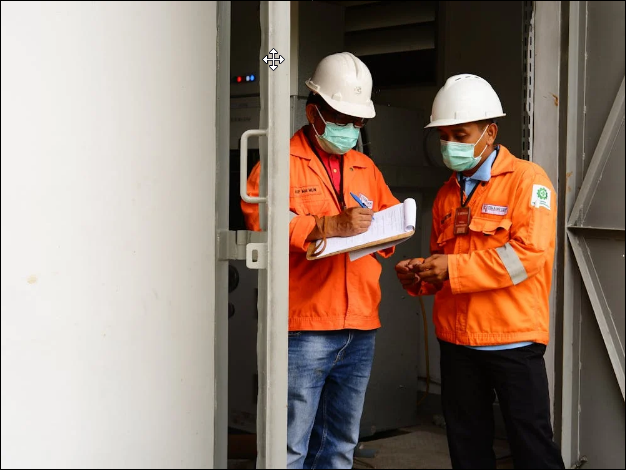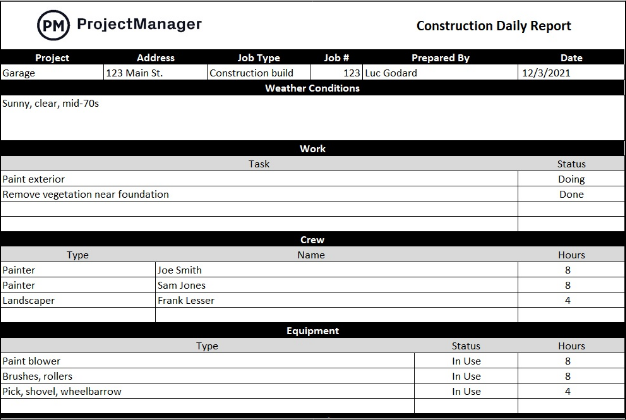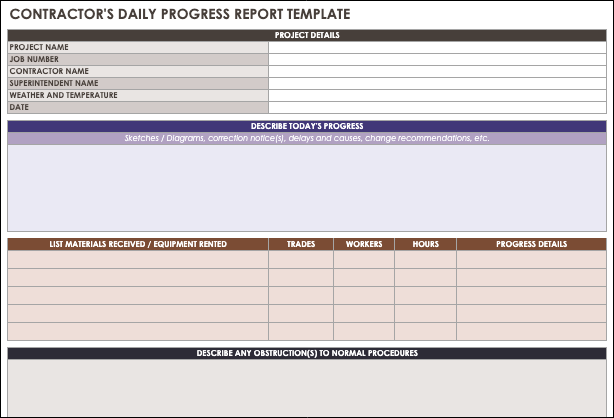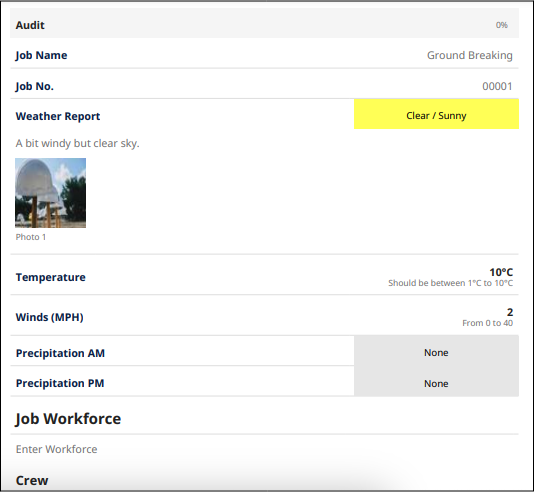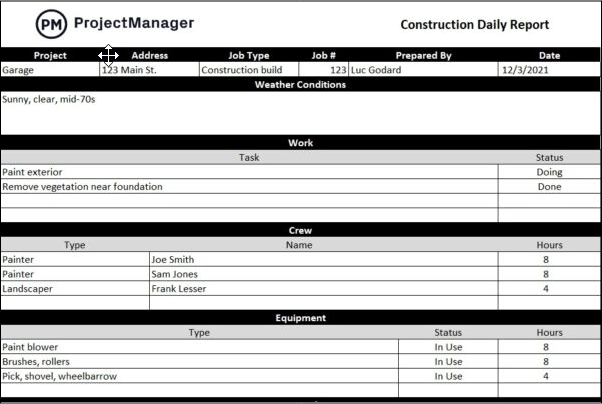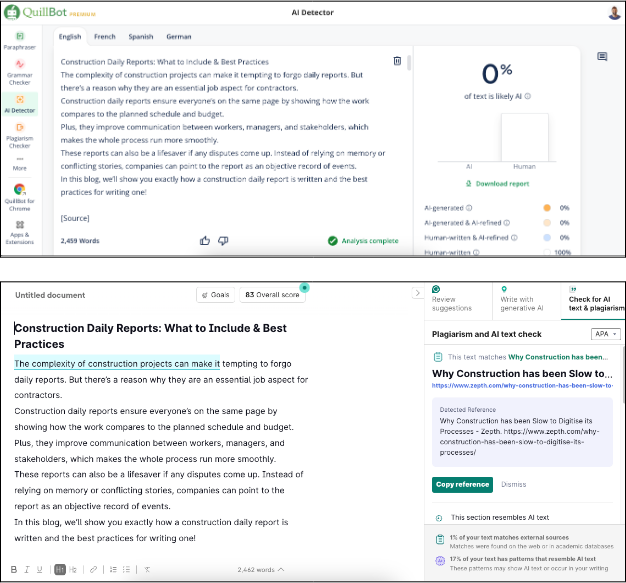The complexity of construction projects can make it tempting to forgo daily reports. But there’s a reason why they are an essential job aspect for contractors.
Construction daily reports ensure everyone’s on the same page by showing how the work compares to the planned schedule and budget.
Plus, they improve communication between workers, managers, and stakeholders, which makes the whole process run more smoothly.
These reports can also be a lifesaver if any disputes come up. Instead of relying on memory or conflicting stories, companies can point to the report as an objective record of events.
In this blog, we’ll show you exactly how a construction daily report is written and the best practices for writing one!
What is a Construction Daily Report?
In layman’s language, a construction daily report is a rundown of everything that happens on a job site each day.
It keeps track of the work completed, materials used, and any unexpected changes or incidents.
As a result, things are more organized so that project managers, clients, and stakeholders stay updated.
Typically, construction daily logs include important details like:
- Date
- Weather conditions
- Number of workers on-site
- Hours worked
- Tasks completed
- Materials delivered and used
- Equipment in use
- Any safety issues or incidents
Why Are Construction Daily Reports Important?
Construction companies heavily invest in service management for construction just so they always have accurate and reliable daily logs at hand.
Here are the five most significant reasons why you should never skip construction daily reports:
1. Helpful in Resolving Disputes
Legal disputes in the construction industry occur more often than you think.
In fact, check out these statistics to know what we’re talking about! In 2021, the no 1 overall dispute cause in the construction industry was poorly drafted or incomplete and unsubstantiated claims.
It clearly shows that keeping daily logs on a construction site can help reduce disputes, boost productivity, and improve teamwork between everyone involved.
When there’s a clear record of what’s happening each day, there’s less room for confusion or disagreements. As a result, you can ensure that the whole process runs smoothly.
2. Improves Accountability
When you know you’re being documented, you tend to be more responsible – it’s human nature.
Hence, daily reports are quite helpful in keeping everyone on a construction site accountable.
They encourage them to stay on track and do their share of the job to keep the project moving forward without any roadblocks.
3. Ensures Safety Management
Construction project documentation is not just for penning down the project’s progress. They also document any safety incidents, hazardous conditions, and other factors that can impact job site safety.
Over time, these reports help identify patterns and recurring issues so the safety protocols can be eventually improved.
4. Ensures Compliance
Construction teams are more likely to stay compliant with industry regulations and legal requirements with daily reports.
These reports also document adherence to labor laws and safety regulations. They track work hours, job conditions, and safety measures, ensuring that everything is being done by the book.
5. Helps with Performance Analysis
Daily reports help track how well a construction project is going by spotting any issues or slowdowns.
They make it easier to improve efficiency and keep things running smoothly. With data from these reports, managers can see where improvements are needed and make smarter decisions to boost productivity.
This also helps with tracking job cost reports and metrics to stay on budget.
What to Include in a Construction Daily Report?
The trick behind creating effective daily construction logs is knowing what to include in construction reports. Following is a checklist you can use.
1. General Information
Each daily report should start with the basics, i.e., the date, a unique report number, and who prepared the report. This ensures that whoever reads the report can quickly find and reference the information they need.
It should also include a headcount of everyone on-site, such as workers, consultants, and vendors, along with the hours they worked.
Don’t forget to include specific details about the location of the project to make it clearer.
Also, including progress photos is always a good idea, too, as they show what’s really happening on the ground.
And don’t skip the weather. Sometimes, sunny or rainy weather can affect the workday, and the reviewer must know that.
2. Work Activities
Here, you’ll note the percentage of the project completed and highlight the main tasks worked on that day.
It’s also a good idea to automate work-in-progress tracking to keep a real-time record of ongoing activities.
If there were any challenges, like a miscommunication or an unexpected delay, be sure to document them.
3. Materials and Equipment
Documenting what materials and equipment were delivered and used on-site helps keep things organized.
This section should also cover any issues, like damaged tools or missing inventory, so that resources are managed properly throughout the project.
4. Inspections
Inspections are a big part of construction, so it’s important to note them in the report.
Whether planned or unexpected, documenting inspections helps keep track of everything being checked and ensures transparency.
5. Safety
Safety should always come first. The daily report should include details about the safety measures in place.
If there were any injuries or safety incidents, they should be recorded here to make sure safety standards are being followed.
6. Budget and Resources Impact
Sometimes, the work done on-site can affect the project’s budget. It’s a great idea to note if any of the day’s activities are likely to change costs or resource use.
This ensures the project stays financially on track.
7. Review & Sign Off
It’s important to know who has reviewed and approved the daily report.
This makes sure everyone is on the same page and communication is clear between the project team.
8. Next Steps
At the end of the report, an action plan lays out what needs to be done next.
This is important to stay focused on the tasks ahead and ensure the project continues moving smoothly and that any problems are addressed quickly.
Best Practices for Creating Construction Daily Reports
If you follow proper construction reporting guidelines, creating a report will feel a lot easier. Here are a few daily report best practices that you can follow:
1. Maintain Accuracy
It’s important to include all the right details, but making them easy to understand is just as important.
All aspects of the report, particularly the consolidated financial reporting, should be clear, with the main points highlighted so the reader can quickly see what happened.
2. Be Consistent
Again, construction reports can seem unnecessary when you’ve other more pressing tasks that need your attention.
However, prioritizing them can save you a lot of undue stress down the road. That’s why you should always complete your daily logs before wrapping up a work day.
3. Use Templates
If you start using templates, you’ll realize creating construction daily reports will be quicker and more effective. Templates can help you standardize the process and ensure that the communication between all parties involved is streamlined.
Also, it’s best if the template you use is familiar and accessible to all stakeholders.
4. Gather Input from Team Members
Contradictory to popular belief, creating a construction report needs to be a highly involved process.
It’s not enough to leave it at the mercy of the project’s supervisor. All team members present at the construction site must be asked to add their input.
This ensures that the report covers all perspectives and contains as many insights as possible.
5. Use Technology
The good news is you don’t have to do everything manually. Instead, you can use digital tools or software for daily reports to make data entry and storage easier.
This helps keep things organized and more efficient, especially when managing tasks like AR Collection Management for Construction Projects.
Steps to Create a Construction Daily Report
Just like the rest of the project, even the daily logs have a thorough step-by-step process.
Following is a quick rundown of how you should approach your construction daily reports.
Step 1: List the Basic Project Details
Contractors have to deal with numerous projects regularly. Start by listing your project’s name, date, location, team, and more.
Also, make sure these details are consistent throughout the project so it’s easier to find a daily report when needed.
Step 2: State the Weather
Is the weather sunny today? Did it rain? Or was there snow?
These details are an important aspect of your report as they impact the project’s progress and the workday’s productivity. So don’t forget to mention this in your report.
Step 3: Add Work Logs
Work logs are perhaps the most essential aspect of daily reporting.
Recording which teams were on-site, their hours worked, and a brief description of their tasks helps track the total time spent on specific projects.
Step 4: Take Photos of the Site
It’s a good idea to take photos of the job site to back up what you write in the report.
It also helps off-site managers get an idea of how far along the process is. These visuals can also serve as proof in case of any disputes.
Step 5: State Any Issues, Notes, or Concerns
Include every major and minor bump in your workday in the report.
This is done to give the reviewer a justification of your productivity levels throughout the day. Moreover, it also prompts action to address issues and concerns.
Step 6: Track Site Safety Observations
As mentioned above, one of the benefits of daily construction reports is their ability to protect you in case of disputes.
A detailed, time-stamped log gives a clear record of daily events on-site. The safety section should document any issues so you can track safety improvements and avoid potential risks over time.
Step 7: Survey and Sign Off
At the end of a report, always remember to include a survey customized to the requirements of your project. For example, the survey could answer questions like if there were any visitors or any unexpected delays.
After everything is done, include the author’s name, signature, and position, and then get it signed by the reviewing authority to ensure the report is approved.
How to Improve Construction Daily Reports
While it’s true practice makes a man perfect, there are also some tips you can follow to improve your construction daily reports over time:
Include Visual Aids
Pictures of the worksite, graphs, and sketches can help make your reports more effective and presentable.
Remember, the goal of adding visual aids is to ensure anyone reading it is able to find the key information as easily as possible.
Maintain an Action-Oriented Tone
Don’t think of the logs as a documentation of the daily events.
Instead, use them as an opportunity to suggest solutions and address challenges. A good report must reflect your critical thinking and decision-making skills.
Communicate and Collaborate with the Team
Everyone in the team should be a part of the process. Make sure you write the construction daily reports after you’ve asked everyone for their input.
Plus, these reports should also be accessible to everyone for complete transparency.
In addition to maintaining clear communication, implementing tools like Timed Cash Forecasting for Construction can help manage financial aspects effectively. How? By ensuring that cash flow aligns with project progress.
Provide Training
Despite their immense importance, many contractors and workers neglect construction daily reports.
You should provide your staff with adequate training to ensure they are well-versed in creating these reports.
Examples and Templates for Construction Daily Reports
If you’re new to writing construction daily reports, here are a few examples to set you off in the right direction:
1. Construction Daily Report Template By Smart Sheet
Check out this construction daily report template by Smart Sheet.
It perfectly summarizes the day’s events and leaves space for noting down delays or recommending changes. It’s simple and easily customizable.
2. Construction Daily Report by SafetyCulture
This downloadable PDF of the construction daily report by SafetyCulture can be a great option for contractors who want to complete their construction daily reports as soon as possible.
3. Construction Daily Report by Project Manager
Here’s a sample construction daily report by Project Manager to give you a sense of how the completed report should look like.
Common Mistakes to Avoid in Daily Reporting
Not Updating Regularly
It’s a common practice to overlook daily construction reports and come back to them a week later.
However, if you want to maintain accuracy and reflect attention to detail, it’s best to complete the report as soon as the workday is over.
Skipping Information
Failing to mention each and every detail simply just beats the purpose of the report.
Make sure you outline all aspects of the day so that your daily reports are not marked incomplete or insufficient when needed.
Not Seeking Feedback
You’ll keep repeating your mistakes until you know what you’re doing wrong.
That’s why you should always ask for feedback on your reports so you can improve their quality over time.
Wrapping Up
Writing construction daily reports only sounds daunting until you make it a regular practice.
And once you realize how beneficial they can be, it would be a not-so-wise move to pass on them.
We hope the tips and insights shared in this blog will help make things easier for you.
Just remember, prevention is always better than cure, and these construction daily reports are like a preventative measure to prevent you from the roadblocks you may encounter later.
FAQs
How long should construction daily reports be?
It generally depends upon the nature and complexity of a project. However, a construction daily report is supposed to be a concise document ranging between one to two pages in length.
Who should create daily reports?
Usually, the site manager should create construction daily reports as they are responsible for supervising all the daily activities at the location.
However, any contractors present can also write their own reports.
What format is best for construction project reports?
The best format for a construction daily report has sections for date, project details, weather conditions, workforce information, tasks completed, materials delivered and used, equipment used, incidents or safety violations, progress photos, and any additional notes or observations.
All these sections should have clear headings to ensure all information is presented in a clear, structured way.
How often should reports be reviewed?
Construction reports must be reviewed daily by the site supervisor or project manager. Any errors or issues in the reports should then be identified and addressed immediately.
Meta Description: Learn what to include in construction daily reports and discover best practices for accurate and efficient documentation that keeps your projects on track.
Grammarly and Quillbot SS:

